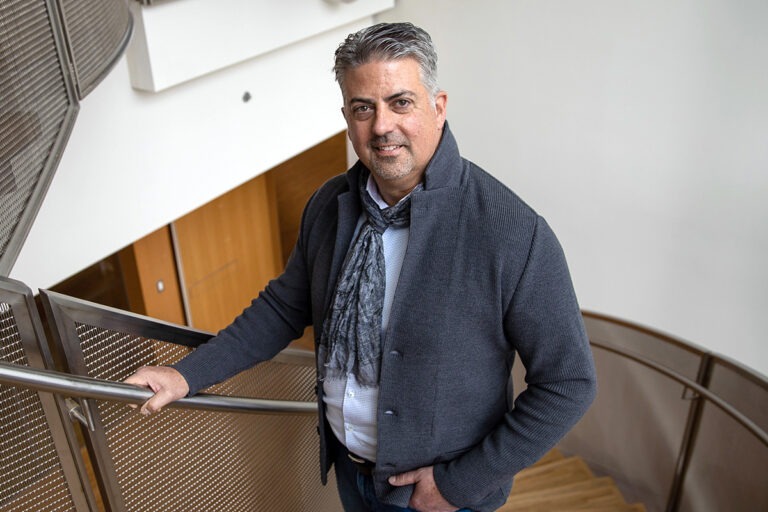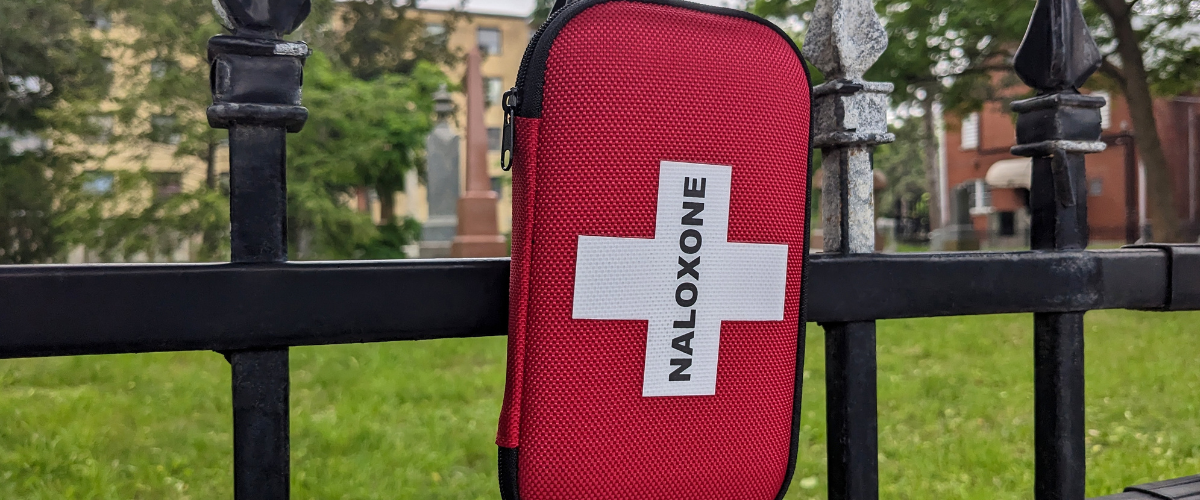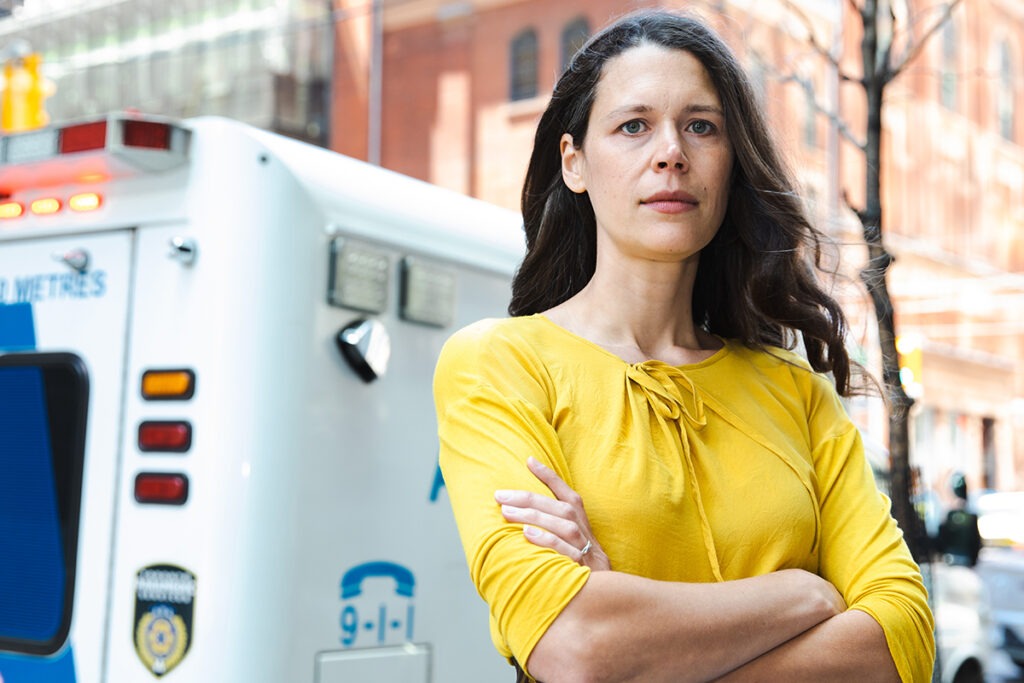Dr. Tara Kiran spoke to The Globe and Mail about the importance of primary care access and about how people who don’t have family doctors are missing out on more than just cancer screening.
Author: Samira Prasad
New smart vending machine in Ottawa revolutionizes access to essential supplies
Dr. Sean Rourke spoke with CTV News about the new Healthbox machine at the Carlington Community Health Centre in Ottawa, the first of its kind in Ontario.
‘We are so incredibly relieved’: Toronto’s drug checking pilot gets greenlight to expand
CBC News spoke with MAP scientist Dr. Tara Gomes and Toronto’s Drug Checking Services‘ lead Karen McDonald about plans to expand the program and offer existing services throughout the province.
“The federal government says the service will help groups across the province design and execute their own drug checking programs, with the original team acting as a “central repository” for the data generated. Researchers with Toronto’s Drug Checking Service will then analyze the data, helping to paint a fuller picture on how unregulated drug supply trends are playing out across the province and comparing them to the rest of the country.“
Cocaine use rising in Canada, new data suggests, as researchers link stimulants to drug deaths
Dr. Tara Gomes recently spoke with CBC about a recent report showing a drastic increase in deaths related to multiple toxic substances, including stimulants.
Health Canada funds 2 key drug checking projects at St. Michael’s Hospital
Unity Health Toronto welcomed Ya’ara Saks, Minister of Mental Health and Addictions, Marci Ien, Minister for Women and Gender Equality and Youth of Canada, and Dr. Leigh Chapman, Chief Nursing Officer of Canada, to St. Michael’s Hospital on Oct. 30 to announced more than $21 million in funding for 52 projects to address the toxic drug and overdose crisis.
The funding was provided through Health Canada’s Substance Use and Addictions Program (SUAP) – and included money for Toronto’s Drug Checking Service, housed at St. Michael’s Hospital, and the emerging drug checking technology DoseCheck.
Toronto’s Drug Checking Service is a community-based public health service that allows people to submit a sample of their drug to be tested and receive results about what’s in it, along with tailored strategies to reduce harm and referrals to drug-related, health and social services.
The program also combines results to perform unregulated drug market monitoring and shares this information publicly every other week to inform those who cannot directly access the service, advocacy efforts, policy, and research.
“Over the past four years, my team has observed firsthand the positive and quantifiable impact drug checking services have on responding to Canada’s toxic drug supply crisis,” said Karen McDonald, Lead of Toronto’s Drug Checking Service.
“This support from Health Canada’s [SUAP] for Toronto’s Drug Checking Service and emerging drug checking technologies, like DoseCheck, will improve access to these potentially life-saving services, promote provincial monitoring of the unregulated drug supply, and, most importantly, contribute to bettering the lives of Ontarians who use drugs.”
Between January 2016 and March 2023, there were 38,514 suspected opioid overdose deaths across Canada, according to the latest federal government data.
“Canada is eight years into an overdose crisis that is leading to more deaths, driven primarily by fentanyl and other high-potency opioids, and the numbers are going the wrong way and exacerbated by the pandemic,” said Dr. Dan Werb, Director of the Centre on Drug Policy Evaluation and co-creator of DoseCheck.
“All Canadians should be able to arm themselves with life-saving information about the toxic compounds circulating in the drug supply. We hope DoseCheck can help do just that.”
DoseCheck, a handheld device that connects to a free smartphone app, is designed to allow anyone anywhere to rapidly test their drug samples with no training required. It was developed in partnership with community health centers, people who use drugs, and government agencies like the U.S. National Institutes of Health and SUAP.
Minister Saks said the funding was part of the renewed Canadian Drugs and Substances Strategy, and that the federal government recognizes the tragic toll the overdose crisis and other substance use related harms are taking on families, friends and communities across Canada.
“We are supporting community organizations who have deep roots in their communities, have the trust of their clients and have the first-hand knowledge needed to make a real difference in people’s lives,” she said.
“We are using every tool at our disposal to end this crisis and build a safer, healthier and more caring future for all Canadians.”
Drug checking services to be expanded across Ontario as drug-related deaths continue to rise exponentially
Toronto’s Drug Checking Service has been awarded two years of support by Health Canada’s Substance Use and Addictions Program to extend and expand the delivery of drug checking services in Ontario. Phase 2 will be led by Karen McDonald – a leader in drug checking service provision and unregulated drug market monitoring, who was responsible for designing and overseeing the program throughout its pilot period – in collaboration with the program’s member organizations. The program will remain housed within MAP Centre for Urban Health Solutions at St. Michael’s Hospital, a site of Unity Health Toronto.
Drug checking is a public health service that aims to reduce the harms associated with substance use by uncovering the contents of the unregulated drug supply. While access has remained limited within Canada, drug checking services in Toronto, across British Columbia, and elsewhere, have had a positive and quantifiable impact on responding to Canada’s toxic drug supply crisis. For example, drug checking:
- Provides potentially life-saving information to those at highest risk of overdose
- Facilitates behaviour change that reduces the risk of overdose
- Provides a new gateway to accessing harm reduction services
- Provides the only source of real time monitoring and public dissemination of unregulated drug market trends
- Provides data that informs clinicians and care and improves health and social services
- Is valuable to people who use drugs, empowering them to advocate for themselves and help develop solutions that impact them.
The pilot program for Toronto’s Drug Checking Service launched in October 2019 within Dr. Dan Werb’s Centre on Drug Policy Evaluation. Over the course of the pilot period, more than 10,000 samples from the unregulated drug supply were checked and over 450 unique drugs were identified – many of which can be directly linked to overdose. Service users, who submitted substance or used equipment samples to be checked, were provided with detailed information on the composition of their drugs, along with tailored strategies to reduce harm and referrals to drug-related, health, and social services via integrated community health agencies (Moss Park Consumption and Treatment Service, Parkdale Queen West Community Health Centre and the TRIP! Project, South Riverdale Community Health Centre, The Works at Toronto Public Health). Samples were analyzed by the clinical laboratories at the Centre for Addiction and Mental Health and St. Michael’s Hospital. Beyond educating individual service users, results for all samples were collated and analyzed to perform unregulated drug market monitoring, then translated and
publicly disseminated every other week to communicate drug market trends to those who could not directly access the service, as well as to inform care for people who use drugs, advocacy, policy, and research.
Key objectives for phase 2 of the program are to:
- Improve access to drug checking in Toronto by increasing the number of sites that offer services
- Support the delivery of drug checking services in jurisdictions across Ontario by sharing tools, resources, and expertise to reduce the barriers associated with offering services while increasing health system efficiencies
- Conduct unregulated drug market monitoring for Ontario by bringing together data generated from checking samples using a variety of drug checking technologies
- Translate findings to advocate for services and safer alternatives for people who use drugs
Toronto’s Drug Checking Service has been without a long-term funding commitment since March 31, 2023. A special thank you to the St. Michael’s Hospital Foundation and Public Health Agency of Canada for their support during this period of uncertainty. Additionally, we thank the community of people who use drugs in Toronto who access our service and provide ongoing feedback to improve it, as well as our members, partners, and collaborators. We are grateful to continue to work with and serve you.
With questions or for more information, please contact:
Karen McDonald, MPPAL PMP | Lead, Toronto’s Drug Checking Service | Director, Program Development and Operations, MAP Centre for Urban Health Solutions, St. Michael’s Hospital, a site of Unity Health Toronto | kn.mcdonald@utoronto.ca
Toronto’s Drug Checking Service is a free and anonymous public health service that aims to reduce the harms associated with substance use and, specifically, to prevent overdose by offering people who use drugs timely and detailed information on the contents of their drugs. Beyond educating individual service users, results for all samples are collated and analyzed to perform unregulated drug market monitoring, then translated and publicly disseminated every other week to communicate unregulated drug market trends to those who cannot directly access the service, as well as to inform care for people who use drugs, advocacy, policy, and research. Sign up to receive reports, alerts, and other information on Toronto’s unregulated drug supply.
Quebec doesn’t know how many homeless people die every year. Why some say that needs to change
Dr. Stephen Hwang spoke to CBC about the importance of collecting data about deaths amongst unhoused people. “You can’t fix the problem if you don’t know how big the problem is and you don’t measure it,” he said.
Canada expands drug strategy to prevent more overdoses, provide additional services
MAP’s Toronto Drug Checking Service was featured in The Canadian Press’ piece on Canada’s recently expanded drug strategy on the overdose crisis. The project has received $2 million over two years from Health Canada as part of this strategy.
Research finds no consistent correlations between police spending and municipal crime rates
No consistent correlations were found between increased police spending and municipal crime rates in a longitudinal study by researchers at the University of Toronto and the Upstream Lab shared in the Advance Access issue of Canadian Public Policy.
“Our analysis found that police services are a top budget priority in most municipalities, with up to 26 percent of total expenditures allocated to police,” wrote Mélanie Seabrook, Researcher at Upstream Lab based at MAP Centre for Urban Health Solutions, St. Michael’s Hospital, with co-authors. However, the findings revealed net increases in per capita spending are not associated with larger reductions in crime rates.
The authors examined budgets of 20 urban municipalities in Canada: Toronto, Montreal, Peel Region, Calgary, York Region, Edmonton, Ottawa, Winnipeg, Vancouver, Waterloo Region, Surrey, Quebec City, Hamilton, Halifax, Laval, London, Gatineau, Saskatoon, Burnaby, and Longueuil.
The study looked at police funding and how it varies across Canadian municipalities over a long period of time. The data from 2010 to 2020 showed wide differences in spending. For example, Vancouver spent more than double per capita on policing in 2019 than Quebec City, highlighting the complexity of the interactions between crime rates and police funding.
Other studies have also had mixed results regarding the relationship between police funding and crime. A 2014 study found no clear relationship between crime rates and per capita police expenditures in Canadian provinces, and a 2015 study of 50 Canadian municipalities found that higher spending on police was associated with higher rates of violent crime, but the direction of the relationship was not established.
Research on police funding is limited in Canada, partly due to the lack of publicly available data on police spending. The study calls for improved publishing of police expenditure data, and for future research to examine whether funding decisions may be based on past crime rates and explore whether investments in police impact future crime rates.
“Although we do not make specific policy recommendations regarding police budgets, our findings raise questions about the reasoning for such vast differences in police funding across the country despite overall downward crime rates,” the authors concluded, who include Upstream Lab Founder & Director Dr. Andrew Pinto and MAP Scientist Dr. Nav Persaud.
“Police Funding and Crime Rates in 20 of Canada’s Largest Municipalities: A Longitudinal Study” was published in Canadian Public Policy Advance Access on October 17, 2023. The official publication will appear in the December issue.
Health Canada announces more than $21 million to support community-based organization who are helping address harms related to substance use
Canada is in the midst of one of the most serious public health crises in our country’s history – the toxic and illegal drug and overdose crisis. No community has been left untouched. That’s why we are leveraging all the tools at our disposal to work towards an end to this national public health crisis—including prevention, harm reduction, treatment, recovery and enforcement.
Today, the Honourable Ya’ara Saks, Minister of Mental Health and Addictions and Associate Minister of Health, announced more than $21 million in federal funding for 52 projects through Health Canada’s Substance Use and Addictions Program (SUAP). With this funding, organizations will be able to increase access to much needed services for those who use drugs and help improve health outcomes for people who are at risk of experiencing substance-related harms.
Investing in programs like SUAP is a key part of the renewed Canadian Drugs and Substances Strategy also released today. The renewed CDSS builds on the work, engagement and consultation since it was originally launched in 2016, including that of the Expert Task Force on Substance Use. The Government of Canada is using an integrated approach to address the overdose crisis and other substance use harms in Canada. Supporting community-based organizations across the country helps reduce stigma and meet the unique needs of the people in their communities where they are at, getting them the services and supports they need, when they need it.
The Government of Canada will continue to work with all levels of government, public health and public safety partners, social sectors, Indigenous communities, stakeholders, people with lived and living experience, and community organizations across the country to support a full range of services and improve health outcomes for all Canadians, save lives and work towards an end to this national public health crisis.
Quotes
“We recognize the tragic toll the overdose crisis and other substance use related harms are taking on families, friends and communities across Canada. Our comprehensive and compassionate approach is about reducing harms, and saving lives. We are supporting community organizations who have deep roots in their communities, have the trust of their clients and have the first-hand knowledge needed to make a real difference in people’s lives. We are using every tool at our disposal to end this crisis and build a safer, healthier and more caring future for all Canadians.“
The Honourable Ya’ara Saks
Minister of Mental Health and Addictions and Associate Minister of Health
“As a harm reduction nurse, I understand the incredible complexities of this devastating crisis. There are multifaceted ways to approach it. Compassionate, lifesaving interventions are not up for debate. I have seen firsthand the lifesaving impact of community-based initiatives and we must listen to the perspective of those with lived and living experience because they know best what is needed.”
Dr. Leigh Chapman
Chief Nursing Officer of Canada
“Over the past four years, my team has observed firsthand the positive and quantifiable impact drug checking services have on responding to Canada’s toxic drug supply crisis. Drug checking can lead to behaviour change that reduces the risk of overdose, generates data that informs clinicians and care, and empowers people who use drugs to advocate for themselves and help develop solutions that impact them. This support from Health Canada’s Substance Use and Addictions Program for Toronto’s Drug Checking Service and emerging drug checking technologies, like DoseCheck, will improve access to these potentially life-saving services, promote provincial monitoring of the unregulated drug supply, and, most importantly, contribute to bettering the lives of Ontarians who use drugs.”
Karen McDonald
Lead, Toronto’s Drug Checking Service
Director, Program Development and Operations, St. Michael’s Hospital, a site of Unity Health Toronto
“As one of the co-chairs of the expert advisory committee on substance use and mental health, I am pleased to see the reflection of the committees important work in the new Canadian Drug and Substance Strategy. Today marks another positive step forward in supporting substance use health. Ensuring a public health approach by including harm reduction as a formal aspect of community based services is absolutely going to make a difference for the health, safety and wellness of all. The renewed model for the Canadian Drugs and Substances Strategy conveys a vision of wholeness, a commitment to the continuity of life for all, and puts forth a good challenge for good change. I look forward to seeing how this strategy translates for equity seeking populations.”
Carol Hopkins
Co-chair of the Expert Task Force on Substance Use
“People are dying, people are suffering and we need to do more to promote substance use health. The renewed CDSS aims to decrease overdose deaths and ensure fairness in access to a full spectrum of services, treatment and harm reduction interventions. I was proud to co-chair the Expert Task Force on Substance Use which called for greater fairness in substance use health and happy that the Government has made that a central part of the new CDSS. Fairness is an important Canadian value.”
Dr. Kwame McKenzie
Co-chair of the Expert Task Force on Substance Use
“As co-chair on the Health Canada Expert Task Force on Substance Use we heard of the devastating impact of the toxic illegal drug crisis in communities across Canada. It was clear that what is needed is a comprehensive strategy that is evidence based and health focused. There is no one solution to this reverse this crisis. Building a range of health services that are available on demand will be the foundation for addressing the harms and supporting persons who use drugs, families and communities that are so impacted.”
Mike Serr
Co-chair of the Expert Task Force on Substance Use
“This is the kind of science that saves lives. Renewing the Canadian Drugs and Substances Strategy is an important step in unifying the field and coordinating a response to increasingly complex and tragic crises. An evidence-based strategy can drive collaboration across sectors to find solutions that are impactful and comprehensive.”
Dr. Alexander Caudarella
CEO of the Canadian Centre on Substance Use and Addiction (CCSA)
Quick facts
- Since 2017, over $500 million has been committed through Health Canada’s Substance Use and Addiction Program for more than 380 projects.
- Through SUAP, the Government of Canada provides funding to not-for-profit organizations, other levels of government, Indigenous communities, academia, and other groups for projects aiming to minimize substance use harms and improve health outcomes for Canadians. These community-led programs and projects leverage the expertise of people with lived and living experience with substance use, and/or are able to reach priority populations in Canada, such as low-income and low-education populations.
- Through new investments announced in Budget 2023, the Government of Canada is also proposing over $359 million, over five years, to support a renewed Canadian Drugs and Substances Strategy, which will continue to guide our work to protect the health and safety of Canadians. The 2023 call for proposals stems from new investments in Budget 2023 that provided $144 million to the Substance Use and Addictions Program.
- The Canadian Drugs and Substances Strategy (CDSS) is led by Health Canada and includes 15 federal departments and agencies. It covers a broad range of legal and illegal substances, including cannabis, alcohol, opioids and other substances that may result in harms. For more information on the approach and the foundational elements visit: canada.ca/drug-strategy.
- Addiction is a treatable medical condition, not a choice—yet many people affected by addiction face stigma and feel shame. The language we use has a direct and deep impact on the people around us.








